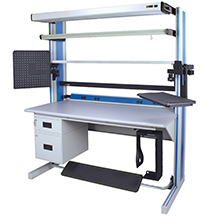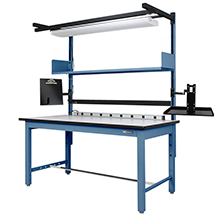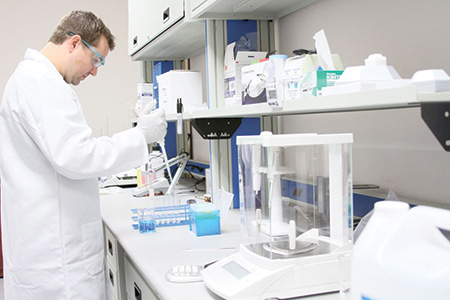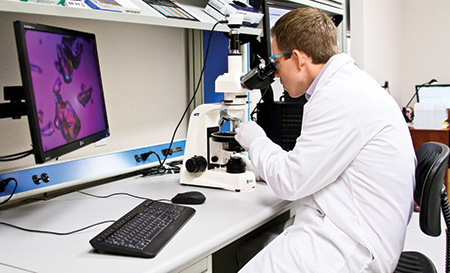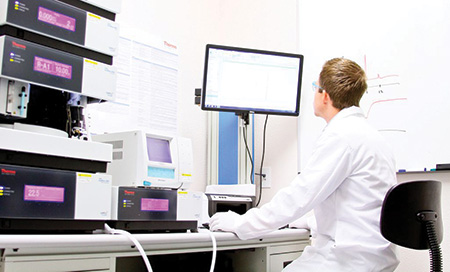How to Outfit a Dynamic Lab in Flux
Imagine yourself as a startup company. As part of your preliminary business plan you determine the need for a productive analytical laboratory in order to thrive as a leader among your business sector. You then discover during your projections that there will be a need to expand your real estate and working area within a year or two. After five years of developing the science behind their KinetiSol® technology and bringing their product to market, DisperSol Technologies found themselves in this exact situation.
Designing and building a productive and efficient modern laboratory requires meticulous planning and often a heavy budget. When combining this planning with the understanding that you will be moving to a larger space in the near future, a project becomes even more complicated. Dave Miller, PhD, Vice President of Research and Development at DisperSol was tasked with this exact challenge.
We spoke to Dr. Miller about his thought process and decision-making in attacking the new lab development.
Editor: We would like to talk to you about your lab decisions. The challenges you faced during initial setup, expansion, and relocation are difficult. Although your action plan to face these challenges is unique, the challenges themselves are known across many industries. Before we discuss how you embraced and found solutions, please first tell us a bit about DisperSol Technologies.
Dr. Miller: DisperSol Technologies was born out of years of research done at the University of Texas on improving the solubility of pharmaceuticals. Many new drug candidates have problems with solubility. Poor solubility makes drug delivery difficult and reduces efficacy due to poor absorption. Our key product, KinetiSol® is a unique process for creating soluble, drug-polymer composites. Imagine the difference between trying to dissolve sand or sugar into water. We work with pharmaceutical companies to turn their 'sand' into 'sugar.' This has tremendous impact on the manufacturability of a drug, its bio-availability, dosage provirtuals,y/and efficacy.
Editor: So, KinetSol® is a solubility-enhancing process. Who does the processing?
Dr. Miller: DisperSol Technologies manufactures the KinetSol processing equipment. Pharmaceutical companies incorporate it into their process chain. As the end user, they do the processing.
Editor: So why does DisperSol need a laboratory?
Dr. Miller: We work closely with the drug manufacturer. Our laboratory analyzes molecular structures and characteristics of the drug candidate. We track down trace crystals, and provide chemical analysis for potency and purity. The results we derive are then used for optimizing the KinetiSol process for that drug.
Editor: So you were tasked with setting up this lab where this analysis takes place. Where did you start?
Dr. Miller: (laughs) Google, of course.
Editor: The internet...
Dr. Miller: Yes, I searched for laboratory furniture and reviewed a great many sites. I initially envisioned a typical lab with built in casework. You know, cabinets and counters. Coming out of the University and "Big Pharma" environments, those were the types of labs I was used to working in; everything built in, permanently attached to walls and floors. Luckily, in my search I discovered the concept of modular lab furniture, which then led me to Dimension 4 lab stations made by IAC LLC, and knew that this was the way to go for DisperSol.
Editor: What was it about the idea of modular furniture that changed your mind?
Dr. Miller: Well, if I had to sum it up in one word, I'd say, "Flexibility." First we had to get set up and running productively very quickly. Setting up a Dimension 4 outfitted lab took just days as opposed to the weeks that built-in casework would have taken. Secondly, we were already preparing for a move to a larger facility for the company. In a year or so we will be able take our entire line of Dimension 4 lab stations to the new facility and be back in action with minimal downtime. And lastly, but just as important, as a young company we have to be prepared for changes-divergences in plan. With the IAC LLC furnishing we are able to reconfigure the lab layout anytime we decide a change will improve processes or workflow. The Dimension 4 lab stations give us lots of options and flexibility.
Editor: Modular furniture for labs has become quite popular in recent years. Why did you select Dimension 4?
Dr. Miller: Well, for starters, they are solid and stable. You get the same sense of permanence as with built-ins, but without all the liabilities that built-in casework carry. For us, the suspended drawers and cabinets were a big plus; in addition to an ample work surface, they provide a great deal of drawer and cabinet space. And because these are options, we can install them wherever necessary. The same goes for the shelving that allows us to position them at any height or angle. It's really quite useful and ergonomic.
Editor: You say "liabilities" of casework. What do you mean?
Dr. Miller: For DisperSol, the obvious is that we can't take casework with us when we leave our current space. Casework becomes part of the facility. And as I previously said, we need to be able to alter our work flow when we discover organizational efficiencies to be had in the layout of our lab. While we have the science down, we are adjusting to growth. Casework is pretty permanent, and modification is both disruptive and expensive. With the modular D4 stations we can turn a straight line work area into a u-shaped cell if we choose to pretty easily with no loss of our existing furnishing investment.
Editor: So, what type of equipment is utilized in the DisperSol lab?
Dr. Miller: In our lab we are typically working with small samples, so most of our equipment resides on the work surface of the D4 lab benches: Mixers, evaporators, concentrators, washers, and microscopes and computers. The workstations incorporate power strips at the rear of the work surface, allowing us to run any of this equipment from any station; much better than relying on the wall outlets. The computers are suspended under the work surface, keeping them off the floor, and we made use of the D4 flat panel display swing-arms. These are particularly effective when using the CCD equipped microscopes where we examine crystalline structures.
Editor: About the planned move. What are your expectations?
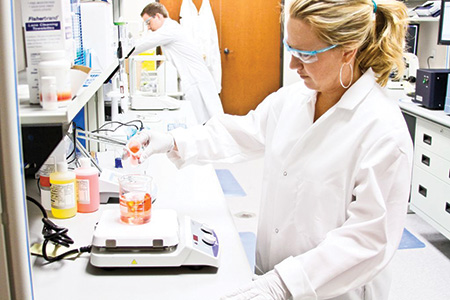
Dr. Miller: With our current rate of growth I expect that we will all be ready for a larger space in less than a year. A move, in even the best cases, is disruptive, but we are planning on just seven days to break down our current lab, move everything and reassemble the D4 stations in the new lab. If things go as planned we may even install additional new furnishings from IAC for the new lab, and move our instruments and personnel when those are ready. That would cut our downtime to a couple of days. I've got a few more months to decide. One thing I can say without hesitation is when you are setting up a new lab, vendor customer service is not a trivial matter. I am confident about our move to a large degree because the service we had from IAC on our current install was excellent, and the quality of Dimension 4 stations is superb-better than I expected in both cases. I know this will carry over to new facility, and that let's me focus on other issues.
Summary
- New or growth companies (laboratories) can benefit from deploying modular lab furnishings.
- Modular work stations/lab stations provide the flexibility for changing companies to protect investment and evolve with less downtime and productivity disruption.
- Modular lab furnishings install faster than conventional casework. They can be redeployed in alternate locations.
- Quality vendors can make a positive difference in the success of furnishing installation.
- When the future is not cast in stone, neither should your lab furnishing.
 Buy Online Now!
Buy Online Now!


